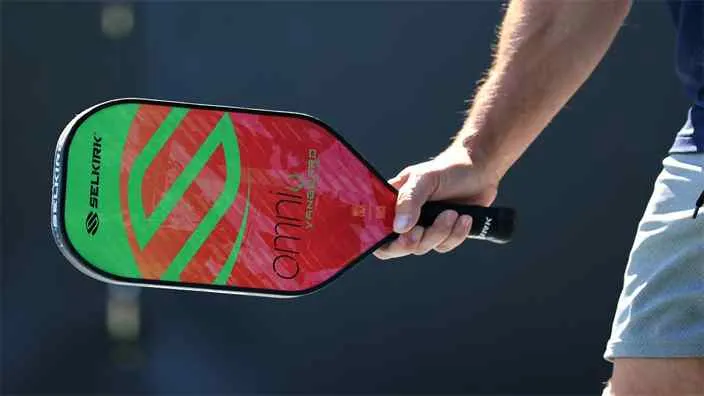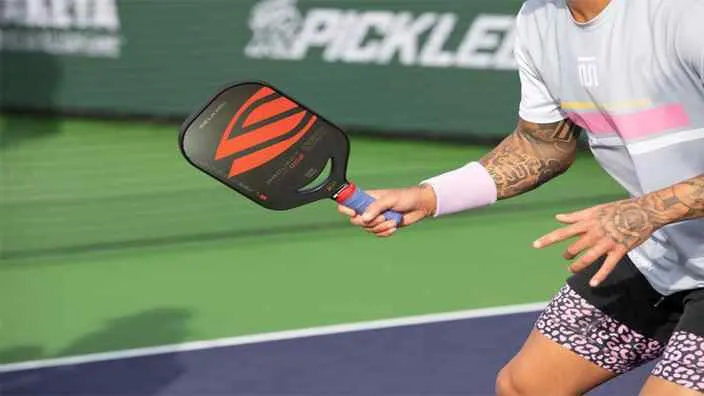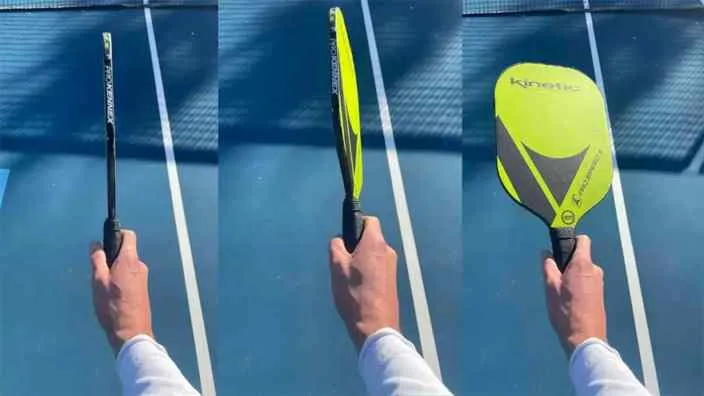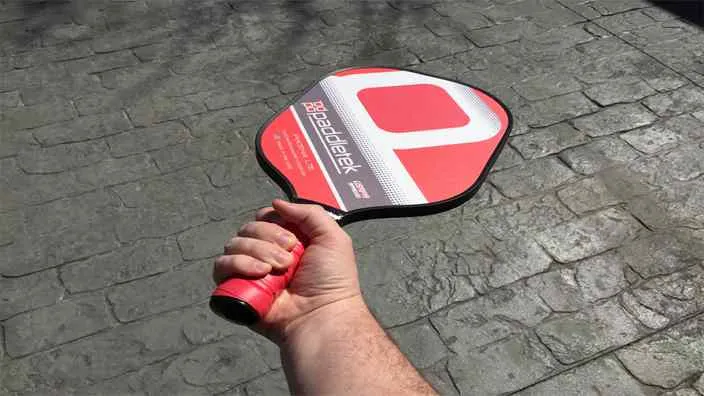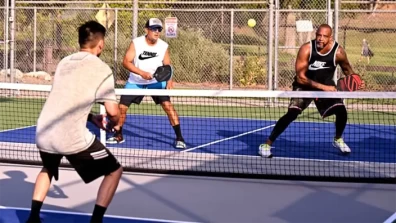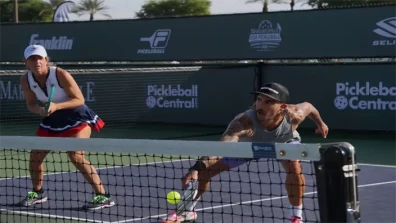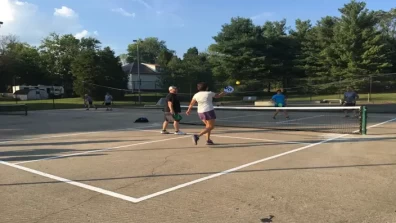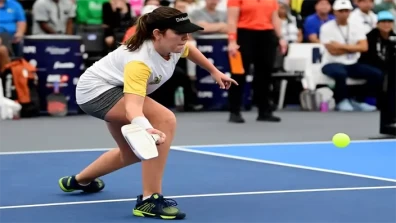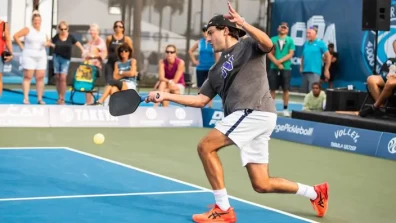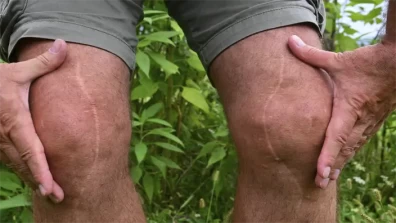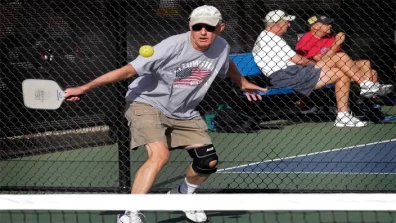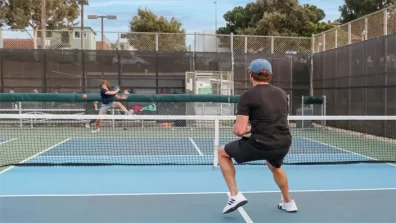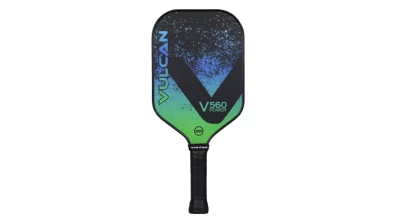Pickleball is a technical game. While it may appear difficult to understand its mechanics at first, with proper guidance, you can go through it like a pro. Amongst everything, what matters the most is your paddle-holding style. If that’s wrong or not suitable according to your expertise, you’re likely to give your opponent an easy win.
Therefore, to help you understand how to hold a pickleball paddle, we have crafted this comprehensive guide. It explores three major types of paddle grips along with their pros and cons. Additionally, we have discussed a few tips to help you in the long run. Let’s dig deeper into the details!
Table of Contents
Exploring 3 Different Types Of Pickleball Paddle Grip
Before mentioning detailed information about three major paddle grips, Continental, Eastern, and Wester, let’s first look at this table. It summarizes their capabilities with respect to different metrics so you can make an informed decision about choosing the grip style accordingly.
| Metric | Continental Grip | Eastern Grip | Western Grip |
| Ease of Learning | Moderate | Easy | Hard |
| Wrist Comfort | Moderate | High | Low |
| Ball Control | High | Moderate | Moderate |
| Power Generation | Moderate | High | High |
| Spin Generation | Moderate | Low | High |
| Serve Performance | Moderate | High | Low |
| Versatility | High | Moderate | Low |
1- Continental Grip
Pickleball coaches typically opt for Continental Grip when it comes to teaching the sport to newbies. Also known as hammer grip, this style mimics holding the tool in a way you’re hitting a nail. If you struggle to find this grip on your pickleball paddle, here’s a trick that can help you go through. Put your index finger’s knuckles at the flat bevel’s right side just on the top of the paddle handle. It will lead to the formation of a V between the index finger and thumb of your right hand. In case you’re lefty, the key is to place your knuckle on the alternate side of the first bevel.
Pros
- Helps hit backhand shots with maximum power
- Produces highly precise dinks and returns
- Does not require grip changing in between the shots
Cons
- Not suitable for forehand hits
2- Eastern Grip
Next, we have Eastern Pickleball Grip, which is equally popular amongst beginner players for its easy implementation. It has another name as well, i.e., handshake grip, due to the resemblance of holding the paddle in a way that you are shaking hands with someone. For this grip, extend your playing hand in front and wrap your fingers around the handle of the paddle like you’re shaking your hands with someone.
To place your index finger’s knuckle, look for the 2nd bevel located at the right side of the paddle handle’s flat bevel on the upper side. A V will form between your thumb and index finger on the right side of the 1st bevel’s top region. However, if your dominant hand is left, place your index finger knuckle on the 2nd bevel to the left side of the upper flat bevel.
Pros
- Effective for hitting backhands, forehands, and serves
- Offers comfort and flexibility to players with its easy hand position
- Ideal for beginners who do not want to change grip during the ongoing game
Cons
- Might not produce ideal topspin, especially for pro players
- Does not provide enough power for expert pickleball enthusiasts
3- Western Grip
Western Grip is basically for intermediate and pro players who have gained enough experience over the other two types. All you need to do is rotate your hand clockwise. Or, in simpler words, move it towards another slope on the right. This way, your index finger’s knuckle will go on the third bevel while it,1 being on the right side of the flat top bevel, will remain constant. As a result, the index finger and thumb’s V will be formed on the 2nd angle. Being a left-hand player, you should place your index knuckle on 3rd bevel to the paddle’s top left side.
This style is almost similar to holding the paddle like a cooking pan when changing the sides of the pancakes. Pertaining to this, it is also called a frying pan grip. If you see the paddle’s back side when holding it straight in your front, it means you’ve got enough experience of Western Grip.
Pros
- Generates maximum power
- Perfect for players who want to go for topspin shots
- Can hit super powerful shots
Cons
- With backhand shots, the ball can go too high unless the player adjusts the wrist position
- It might be challenging to make hits from down the low side
Read More: Diving Deep Into Pickleball & Wiffle Ball Differences
Tips For Holding Pickleball Grip Like A Pro
As a beginner, it is best to stick to one grip throughout the game. However, if you have gained enough experience, you can switch between different pickleball grip styles for each shot. Let’s explore a few tips that can help you achieve this like a pro:
- Never try to get expert at all three grips altogether. Take it once at a time in the following sequence: Continental, Eastern, and Western.
- Get a pickleball machine and try each style in practice matches. Change conditions to excel in different scenarios.
- Note down which type of shot is played the best with which style, then practice accordingly.
- When on the court, have a keen eye for your competitor’s paddle-holding style. This way, you can judge the type of shot that’s coming and adjust your grip accordingly.
- Do not limit your practice sessions alone or with your friends. Instead, approach a professional coach to work on your weak points.
How To Hold Pickleball Paddle When Serving?
If you are a beginner, you might hold your paddle too tight, which is, of course, not the right approach. Another mistake that novice players commit is to clutch the equipment in their palms and not the fingers of their hands. It’s a major problem that may lead to lower control over the paddle. Moreover, it also results in a loss of sensitivity to the shots. Generally, you should go for a relaxed grip on the palm’s side. The pressure should be on the fingers for better control over the paddle and the shot’s direction as well.
Ways To Increase Pickleball Grip Pressure & Strength
Besides employing the right paddle-holding technique, it’s equally crucial to increase the strength of your dominant hand to become a pro player. Not only does it help with hitting powerful shots, but it also increases their preciseness. Moreover, it is a quite efficient way to switch between grips for each shot. But how can you do so? Well, try out a few hand and forearm exercises like:
- Finger Stretch
- Squeeze
- Thumb & Finger Extensions
- Gentle Fists
- Rubber Band Exercises
- Reverse Curl
- Crab Walk
- Plank Should Tap
Frequently Asked Questions
How Do I Hold A Pickleball Paddle Aa A Beginner?
Beginners should opt for the Eastern Grip and hold the paddle in their dominant hand. Also, the grip should be relaxed and not too tight. The base of the index finger knuckle should align with the paddle’s flat face. And the thumb must rest against the back of the handle for optimum support.
How Do I Swing A Pickleball Paddle?
Here’s a short guide to swinging a pickleball paddle:
- Ensure a comfortable paddle grip.
- Sand with feet-shoulder width apart.
- Pull the paddle back with your arm.
- When swinging, come forward with your alternate foot.
- Swing the paddle forward to hit the ball. Use your hips and shoulders to ensure a powerful shot.
- Continue swing motion naturally after the point of contact.
How Do I Choose A Pickleball Grip?
To choose the pickleball grip, measure the distance from the lateral crease’s bottom side to your ring finger’s extreme tip. Typically, the values are around 4 to 5 inches and demonstrate your grip size effectively.
Can I Touch The Paddle In Pickleball?
While you can touch the paddle with your playing hand to hold it, doing so with your non-dominant hand is not allowed in this sport. It results in a fault, leading your opponent player to earn a point. It’s the USA Pickleball Association that determines these laws.
How Can I Practice Pickleball Strokes?
When practicing pickleball strokes, you first need to understand the mechanism behind basic strokes, including volley, groundstroke, and serve. Additionally, practice against a wall to enhance your consistency. Similarly, practicing swings without a ball can help build muscle memory. These are known as shadow swings. Make sure to practice regularly and take lessons from a coach for personalized feedback.
Conclusion
To wrap up, I hope you’re now clear on the different types of paddle-holding grips. So go with the one that suits your expertise level in this sport. For beginners, Eastern and Continental Grip are ideal. Meanwhile, advanced players can benefit the most from the Western method. In addition to this, practicing regularly by switching shots mid-rally is also required to excel at this sport. That said, do tell us your favorite paddle ball grip in the comments below. I am also looking forward to hearing your insights on which style benefits you the most on the court.

